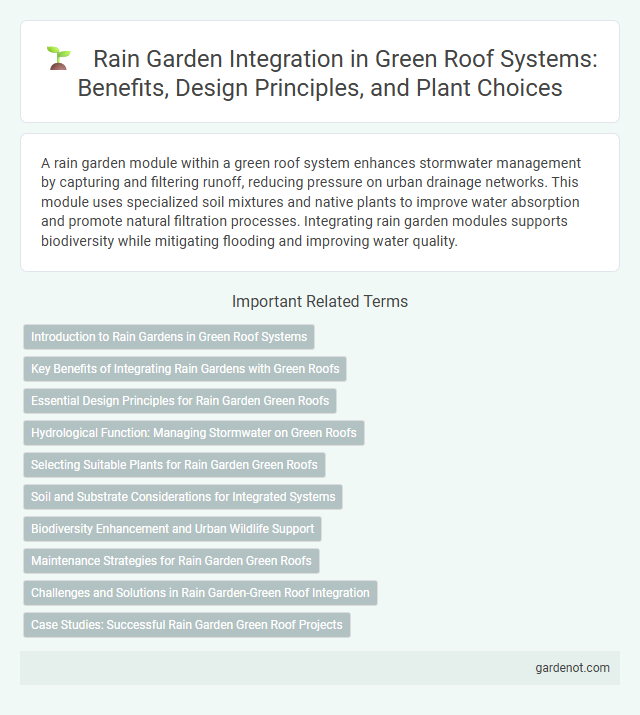A rain garden module within a green roof system enhances stormwater management by capturing and filtering runoff, reducing pressure on urban drainage networks. This module uses specialized soil mixtures and native plants to improve water absorption and promote natural filtration processes. Integrating rain garden modules supports biodiversity while mitigating flooding and improving water quality.
Introduction to Rain Gardens in Green Roof Systems
Rain garden modules integrated into green roof systems efficiently manage stormwater by capturing and filtering runoff, reducing urban flooding. These gardens employ native vegetation and engineered soil layers to enhance water infiltration and pollutant removal. Incorporating rain garden modules improves biodiversity and contributes to sustainable urban drainage on rooftop environments.
Key Benefits of Integrating Rain Gardens with Green Roofs
Integrating rain garden modules with green roofs enhances stormwater management by significantly reducing runoff volume and improving water quality through natural filtration processes. These systems increase urban biodiversity by providing habitat for pollinators and native plants, while simultaneously mitigating urban heat island effects and lowering building energy consumption. The combination promotes sustainable urban infrastructure, contributing to resilient ecosystems and improved climate adaptation strategies.
Essential Design Principles for Rain Garden Green Roofs
Rain garden modules in green roofs prioritize effective stormwater management through permeable soil layers and native plant selection that maximizes water absorption and filtration. Essential design principles include optimizing slope gradients between 1-5% to facilitate appropriate drainage without erosion, and incorporating overflow systems to handle excess rainwater during heavy storms. Proper soil media composition with high porosity and nutrient retention supports plant health and enhances pollutant removal in rain garden green roofs.
Hydrological Function: Managing Stormwater on Green Roofs
Rain garden modules on green roofs enhance hydrological function by efficiently capturing and filtering stormwater runoff, reducing peak flow rates and promoting groundwater recharge. These systems use specialized plant substrates and vegetation to absorb and retain rainwater, mitigating urban flooding and improving water quality. Incorporating rain garden modules supports sustainable stormwater management, aligns with LEED certification standards, and decreases the burden on municipal drainage systems.
Selecting Suitable Plants for Rain Garden Green Roofs
Selecting suitable plants for rain garden green roofs involves prioritizing species with high water absorption and drought tolerance to manage stormwater efficiently. Native perennials, such as sedges, rushes, and water-loving wildflowers like blue flag iris or swamp milkweed, thrive in variable moisture conditions and support local biodiversity. Incorporating deep-rooted plants enhances soil stability and pollutant filtration, optimizing the green roof's environmental benefits.
Soil and Substrate Considerations for Integrated Systems
Rain garden modules in green roof systems rely on specialized soil and substrate layers designed to optimize water retention and drainage. Engineered substrates typically combine expanded shale, sand, and organic compost to enhance porosity while supporting plant growth and microbial activity. Proper soil composition ensures pollutant filtration, stormwater management, and longevity of the integrated green roof system.
Biodiversity Enhancement and Urban Wildlife Support
Rain garden modules significantly boost biodiversity by providing native plants and habitats that attract pollinators, birds, and beneficial insects. These green infrastructure elements improve urban wildlife support by creating micro-ecosystems that filter rainwater and offer shelter within city environments. Integrating rain gardens into green roofs enhances ecosystem resilience and contributes to sustainable urban biodiversity management.
Maintenance Strategies for Rain Garden Green Roofs
Effective maintenance strategies for rain garden green roofs emphasize regular inspection of drainage outlets to prevent clogging and ensure proper water flow. Periodic removal of sediment and debris, along with seasonal pruning of vegetation, supports plant health and maximizes stormwater retention capacity. Utilization of native, drought-resistant plant species reduces irrigation needs and enhances the sustainability of rain garden green roofs.
Challenges and Solutions in Rain Garden-Green Roof Integration
Rain garden modules in green roof integration face challenges such as water retention limitations, soil erosion, and plant survivability under varying urban microclimates. Solutions involve optimizing soil media composition to enhance permeability and moisture retention, incorporating native drought-resistant plant species for resilience, and employing structural reinforcements to prevent runoff and erosion. Advanced irrigation systems paired with real-time moisture sensors improve water management, ensuring consistent hydration and reducing maintenance demands.
Case Studies: Successful Rain Garden Green Roof Projects
Case studies of successful rain garden green roof projects highlight significant stormwater management improvements, as seen in Seattle's Bullitt Center, where a rain garden green roof reduced runoff by 70%. The Portland EcoTech Building incorporates native plants in its rain garden green roof, enhancing biodiversity while managing over 25,000 gallons of rainfall annually. These projects demonstrate sustainable urban design's potential to mitigate flooding and improve water quality through innovative green infrastructure.
Rain garden module Infographic

 gardenot.com
gardenot.com